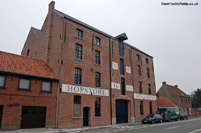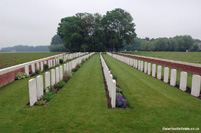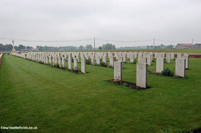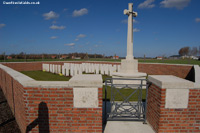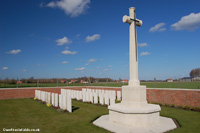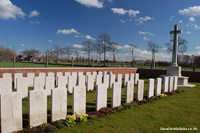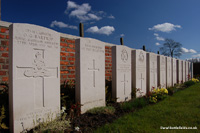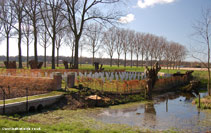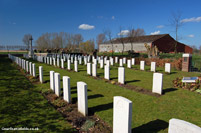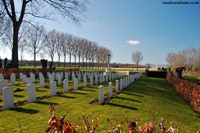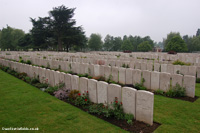Behind the Lines
The World War One Battlefields site is undergoing a major update, with pages being converted to a new, user-friendly mobile format. The updated pages can be found at Updated World War One Battlefields. Some pages such as this one amd the others in the left hand menu remain in the original format pending update. Much more content is available on the Updated World War One Battlefields site.
This page covers areas which were situated behind the front lines in the Flanders area during the Great War - mainly to the west of Ypres. The principle town behind the lines in this sector was Poperinghe, which is covered by a seperate page.
Travelling west from Ypres on the N308, this joins the main N38 leading west. However, staying on the N308 means one can visit many of the interesting sites to be seen between Ypres and Poeringhe. Continuing on the N308, the first village reached is Vlamertinge, and the Hop Store is located on the right hand side of the road. This building was used as an Advanced Dressing Station (ADS) during the Great War.
Just a little further west and located to the right (north) of the road is Hop Store Cemetery , a small narrow cemetery. It was started in May 1915, and although it would have just been within range of some of the German artillery, it was used until 1917. The size of the cemetery was constrained by its location, between a hedge and the Hop Store itself. Low lying, it was marshy and the site was drained by the Royal Engineers early in 1917. According to the cemetery plan there used to be a moat at the far end of the cemetery, but there is no sign of this now. The grave rows run mainly parallel with one of the boundary walls, but the other wall curves in, and the rows of graves themselves curve slightly.
As always, there are interesting graves and inscriptions to be found here. Major Harold Philby was commanding the 2nd York and Lancasters when he died on the 17th of May 1916. He was the uncle of the famous spy, Kim Philby. Lance Serjeant Edgar Pallett from Nuneaton was perhaps known by a nickname derived from the first letter of his surname and part of his first name - the inscription on his headstone reads "To dear Peg from sorrowing mother and father. Faithful unto death". The inscription on George Telfer's headstone reads "Remembered by his loving wife and three little children". George, from Newcastle, was 35 when he died of wounds on the 9th of June 1917.
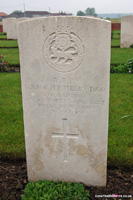
Grave of Major Philby at Hopstore Cemetery
The register shows that some of those buried here were not directly victims of the war itself; Driver John Craig of the Royal Field Artillery died of accidental injuries on New Years Day, 1916. Some buried here started in the ranks but rose to become officers. Second Lieutenant Frederick Martin, from Edinburgh, enlisted as a private in the Artists Rifles in September 1914, but was commissioned into the Sherwood Foresters, and died of wounds aged just 20 serving with 'A' Company of the 2nd Battalion on the 7th of September 1915. Some of the detail the register gives is facsinating; for instance it records that Second Lieutenant Alexander King of the 18th Hussars "died of wounds (gas)" on the 24th of May 1915. There was a German gas atack that day near St. Julien,described as being about three miles long and forty feet deep.
Continuing west, the next village reached is Brandhoek. There are a number of war cemeteries here, and Brandhoek New Military Cemetery is reached by turing left off the main road (to the south) and then right. Field Ambulances were based in the village as it was relatively safe from German shelling. The cemetery was started in July 1917, when the 32nd, 34th and 3rd Australian Casualty Clearing Stations arived in the area to prepare for the major offensive launched at the end of that month which would become known as Third Ypres. The cemetery was used only for a couple of months. It is located just off the road up a grass track, and is long and narrow in layout with four German graves just to the right of the entrance and more further in and at the far end of the cemetery. All of the graves face away from the entrance.
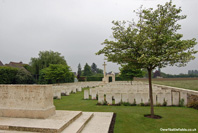
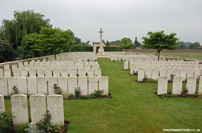
Brandhoek New Military Cemetery
The most famous burial here is that of Captain Noel Chavasse, the only man in the First World War to be awarded the Victoria Cross twice, and one of only three men ever to acheive the honour of VC and bar.
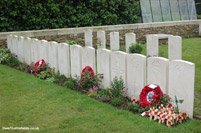
The row containing the grave of Captain Noel Chavasse, VC and bar
As one might expect, the register devotes a considerable space to this brave man, who was the son of the Bishop of Liverpool. Noel Chavasse was born in 1884, and gained a First Class degree in Philosophy from Trinity College Cambridge. He qualified as a doctor in 1912, and worked at the Royal Southern Hospital in Liverpool. When the First World War started, he joined the Royal Army Medical Corps and was attached to the 10th Liverpool Scottish. He was with them when when he won the Military Cross in June 1915, going out into No Mans Land for 48 hours to bring in the wounded. Just two months later he won his first VC when near Guillemont on the Somme the battalion sustained casualties amounting to nearly a third of their strength. Chavasse again brought in the wounded, and under heavy shellfire bought a badly wounded man in. He was wounded himself, but continued to search for the wounded, along with 20 volunteers. It was estimated that in two days he probably saved the lives of some 20 men. His second VC was won in Flanders, when on the first day of Third Ypres (the 31st of July 1917) his battalion attacked near Wieltje, north-east of Ypres. Chavasse sustained a head wound but refused to leave, and in the appaling weather that was a feature of the battle he went out again and again to rescue the wounded, once more saving many lives. Early in the morning of the 2nd of August 1917 he was taking a short rest when his position was struck by a shell, and although wounded in six places Chavasse crawled half a mile to seek help for the others that had been wounded. He was evacuated, but, badly injured, died on the 4th of August - but only after dictating a letter to his fiancee Gladys saying that 'duty called and duty must be obeyed'. He was a truly selfless and brave man.
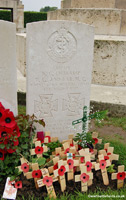
The grave of Captain Noel Chavasse, double VC winner
Near his grave when I took these pictures was a printed photo of Noel Chavasse; rain streaked and faded, but showing the mild-mannered and ordinary face of this extraordinary man.
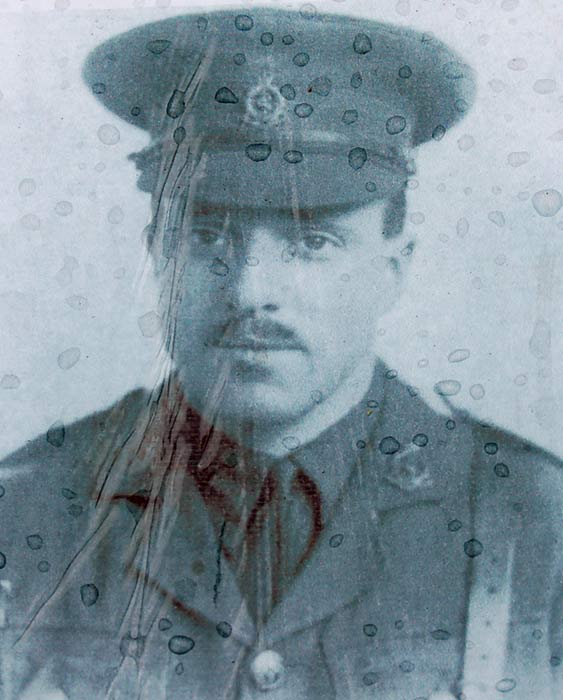
Captain Noel Chavasse
Not far from the cemetery is a memorial to Captain Chavasse; very similar in appearance to one erected to the poet Franis Ledwidge near Boesinghe. The memorial is brickbuilt, with perspex panels fixed to it. The one at the top gives some historical background on Captain Chavasse, and the one below shows a drawing of him.
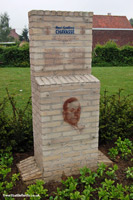
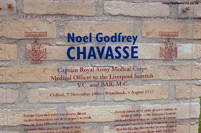
Memorial to Captain Noel Chavasse
Continuing west from Brandhoek, on the right hand side of the N308 shortly after the village is Red Farm Military Cemetery This is a very small cemetery, with just three rows of graves and only 46 burials, 17 of which are unidentified. The cemetery was established during the Battle of the Lys and used only in April and May 1918. This small cemetery has no register on site, and also no Stone of Remeberance.
Red Farm itself stood a little to the left of the cemetery as you look towards it from the road, and by 1918 a trench line ran north-south just to the right of the cemetery. There were also camps nearby, including one at Red Farm itself, and another, York Camp, at the crossroads about a quarter of a mile west. One interesting wartime place name further east in Brandhoek itself was Wobbly House - perhaps a building which had been damaged and become structurally unsound, thus earning the name?
Continuing west on the N308, taking the next right leads to the site of one of the many camps which were established in this safer rear area - Dirty Bucket Camp. As the road bends left and then right, there is a plaque marking the spot, although the camp itself was actually a little further west within the woods. There were other camps - 'D' Camp , 'O' Camp and Border Camp - also in this vicinity. A few hundred yards north-west was a building known as the 'Gin Palace'.
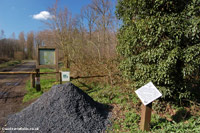
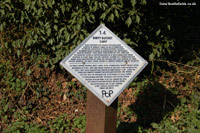
Approximate site of Dirty Bucket Camp
Continuing along this road leads to a cross-roads - known in the war as Dirty Bucket Corner. Turning right here leads to Hospital Farm Cemetery, located on the right hand side of the road. There is a parking area by a gate and a track flanked by tall trees leads from this to to the cemetery which is set some distance back from the road. Farm buildings stand just to the right of this track as they did before the Great War, and this was Hospital Farm, but the temporary war-time buildings of Hospital Farm Camp were actually located on the other side of the road. At the end of the track another gate leads to a small bridge which crosses water to the cemetery gate itself. This ditch, which by the cemetery is water-filled, can be seen running alongside the track back to the road, and this 'moat' was marked on trench maps.
This is a fairly small cemetery, surrounded by pollarded trees cut quite short. It contains 116 burials, only three of which are unknown. Its name came from a building at the farm which was used as a dressing station , and the cemetery itself was used mainly in 1915 and 1917. By 1918 a light railway ran right next to the cemetery. There is one French civilian buried here who was killed nearby - Marcel Top. His gravestone differs from the others: it has a square top with the corners nicked, and is inscribed wth just his name, the date he died (11th August 1915) and a cross. Among the graves here is that of Lieutenant Lambert Playfair who was serving with the 1st Squadron of the Royal Flying Corps when he was killed in action at St. Julien on the 6th of July 1915. He was aged just 21, and was the son of Jessie and Harry Playfair of Assam in India. He gained a prize cadetship to Sandhurst in 1912 and was gazetted to the 1st Royal Scots in January 1913. Also buried here is Private John Ashton from Pontefract who arrived on the Western Front with the 5th Battalion of the King's Own Yorkshire Light Infantry on the 29th of June 1915. He died of wounds recieved at Vlamertinghe on Boxing Day 1915, aged 35.
Lijssenthoek Military Cemetery
Lijssenthoek is now covered by an updated page on the new format website; see Lijssenthoek Military Cemetery.
Some distance away from the other sites described on this page, but worthy of an extended visit is Lijssenthoek Military Cemetery, located south-west of Poperinghe and reached by following the N38 south from the ring-road around Poperinghe, and taking the first left and then following the road to the right.
During the war, the location was also known as Remy Sidings, and was the location for a number of Casualty Clearing Stations. There were many structures in the vicinity marked on trench maps with the legend 'Hospital'. Farm buildings stood just north-west of the cemetery, and this was known as Corfu Farm during the war. A railway line ran not far away, and today the N38 you probably followed to reach the cemetery runs along the same route that the railway lines ran during the war. In April 1918 the Casualty Clearing Stations were withdrawn as the Germans launched their great offensive, but Field Ambulances were located here instead.
This is the second largest Commonwealth War Cemetery in Belgium (the largest is Tyne Cot) with 10,754 burials - 9,901 of which are Commonwealth soldiers, the remainder mainly French and German. The dates 1914-1920 are inscribed above the imposing entrance way which has large cast iron gates set within it. There are French graves just inside to the left and German graves at the front right, but most of the French and German graves are loctated towards the rear of the cemetery. There is also a small plot of Chinese graves. The cemetery was originally started by the French 15th Hopital d'Evacuation, and used by British forces from June 1915.
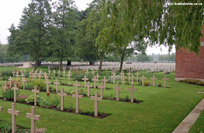
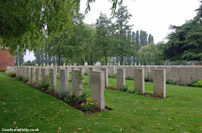
French (left) and German (right) war graves at Lijssenthoek Military Cemetery
In parts at least, there is an interesting distinction between the burials of officers and orther ranks. The graves in the front rows of Plots 14, 15 and 16 are mainly officers, with other ranks buried in the rows behind. There are rows of officer graves in other parts of the cemetery too - such as Plot 2, Row A.
I have a postcard showing this cemetery shortly after the war, when the original crosses were still in place. Several names are clearly visible on this, allowing the location to be determined - it shows Plot 14. The cross marking the grave of Victor Bundock shows he was a 1st Air Mechanic with 21 Squadron, although the CWGC entry lists him as Airman 1st Class. He was aged 23 when he died on the 27th of June 1917. Victor Bundock was born and brought up in Southend-on-Sea, the son of a Draper's Assistant. Visible in the row behind is a cross to Driver R Hargreaves. The register shows that this is the grave of Rowland Hargreaves who served with the E.E. Cable Section of the Royal Engineers, attached to the 1st Anzac Corps. This Section would have laid signal cables, often from horse-drawn cable carts. Hargreaves was from Leeds and was a tailor's runner and just 21 years old and 5' 6" tall when he enlisted in December 1914. After training he was based for a while in Alexandria, and arrived in France in April 1916. He died on the 24th of June 1917. The Nissan hut visible in this old picture is more or less where the large tree near the Stone of Remembrance now stands - see the comparison picture of the cemetery today below the postcard view.
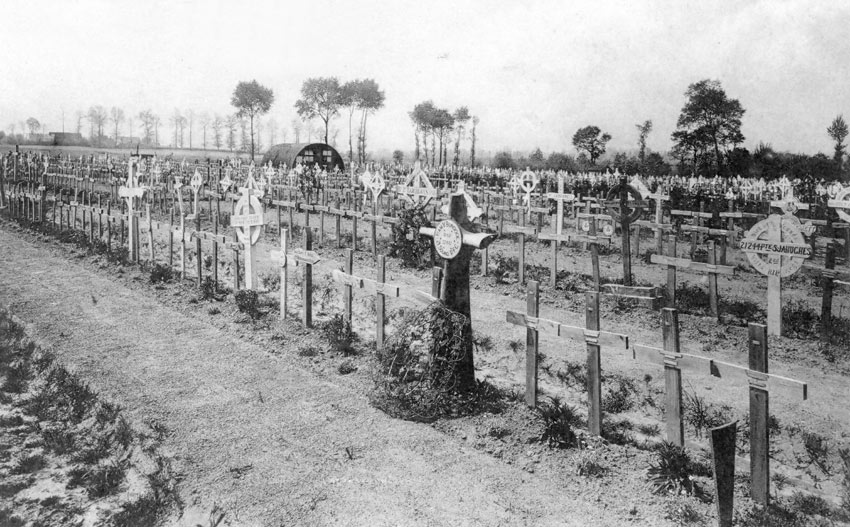
Plot 14 at Lijssenthoek Cemetery shortly after the war. Photo: Sansen-Vanneste
As this is a large cemetery, there are a number of senior officers buried here, giving lie to the myth that the Generals in the Great War kept safe and sound out of harms way. One such man is Brigadier-General Alister Gordon, who commanded the 153rd Infantry Brigade, and was a veteran of the Ashanti Campaign of 1901 and also the South African War. He died of wounds on the 31st of July 1917 aged 45. On that day, the 153rd Brigade, part of the 51st Highland Division, attacked at 3.50 a.m. south-east of Langemarck on the first day of Third Ypres.
Amongst the men buried here is one woman - Staff Nurse Nellie Spindler of the Queen Alexandra's Imperial Military Nursing Service. From Wakefield, she was with the 44th Casualty Clearing Station then based near Brandhoek when she died on the 21st of August 1917, aged 26. That day, the Germans shelled the area around the 44th CCS at around 10 a.m., critically wounding Nellie, who was in bed at the time and who died within a few minutes. The CCS moved that same day to Lijssenthoek, and Nellie was buried here with full military honours and with the Last Post played over her grave. She was officially described as 'killed in action' by the War Office, and had only been on the Western Front since May 1917. According to the CWGC records she is one of only two female Great War casualties who are buried in Belgium. The other is Mabel Gladstone, also a nurse with the Queen Alexandra's Imperial Military Nursing Service, who is buried at Belgrade Cemetery near Namur.
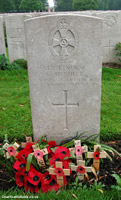
Nellie Spindler's grave at Lijssenthoek
An Australian soldier buried here, Private John Donald Sutherland, known as 'Don' had enlisted on the outbreak of War in August 1914. He had certainly seen his share of action by 1917, having been hospitalised with gun shot wounds in Gallipolli and Malta in 1915 and admitted sick to hospital in France in 1916. He suffered gun-shot wounds and a fracture of his right leg on the 3rd of October 1917, before dying from these wounds at the 3rd Canadian Casualty Clearing Station the next day. He did not have a spotless disciplinary record, having been fined on a number of occasions for various offences, mainly when in England. His nephew was named after him, and wrote in 1969 asking for information on his uncle's Gallipoli Medal. The Gallipoli Medal was designed for ANZACs who had fought at Gallipoli, buut was not awarded during or in the period after the First World War, as there were disputes around its award to soldiers of other nations who had fought on the pennisula. In fact, questions were raised in the House of Commons about its award to units such as the 29th Division, and it was not until the 1960s that the medals were awarded to surviving soldiers or qualifying next of kin. Sutherland's medal was claimed by his nephew, Captain Donald Ross Sutherland, then also serving with the Australian Army. John Sutherland himslef served with the 10th Australian Infantry Battalion, and on Wednesday the 3rd of October 1917 they had just come out of the line near Zillebeke after some fierce fighting during which Sutherland may have sustained the wounds that proved fatal.
Lijssenthoek is a quite enormous cemetery, although it is very hard to convey this with photographs due to the many trees which break up the view. The two pictures below may perhaps give some impression of its size.
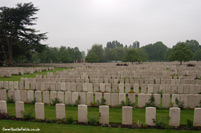
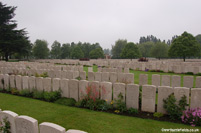
Lijssenthoek Military Cemetery
Just to left of the Stone of Remembrance, Plot 32 consists of two rows of headstone set in semi-circles; one short and one long. Those in the front row are in fact special memorials to men known to be buried here but the location of whose graves is now not known. Interestingly, there are two graves of American soldiers set near one another but apart from the other burials. These are the graves of James Pigue of Tennesee, a Lieutenant in the 117th Infantry who died on July the 18th 1918, and also Larry King from New York.
Sources & Acknowledgements
Michael Ashcroft: Victoria Cross Heroes
Beatrix Brice: Battle Book of Ypres
British Journal of Nursing, September 8th, 1917
Commonwealth War Graves Commission website
Great War Forum
Francis Ledwidge Centre website
Major & Mrs Holt: Battlefield Guide to the Ypres Salient
National Archives of Australia website
Wakefield Family History Sharing website

